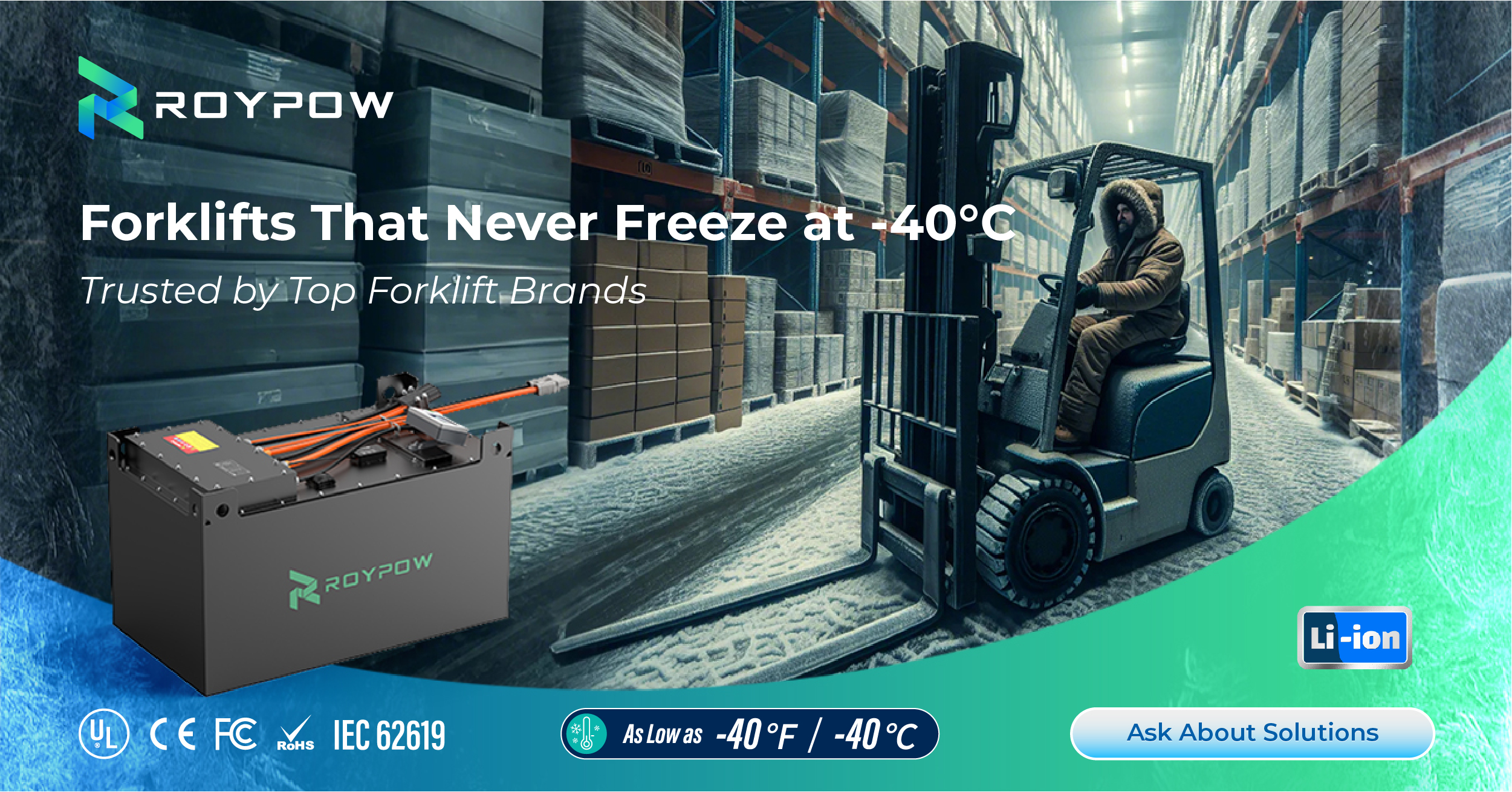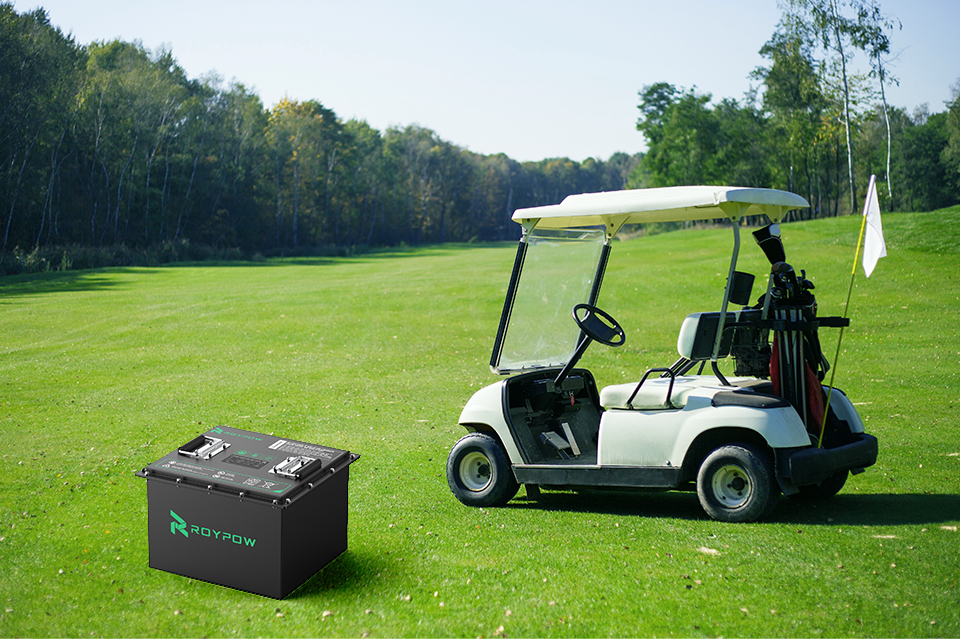Industrial batteries aren’t just about keeping equipment running. They’re about eliminating downtime, slashing operational costs, and making your warehouse, workshop, or industrial site run like a well-oiled machine.
You’re here because lead-acid batteries are costing you money, time, and patience. This guide breaks down everything you need to know about modern industrial battery technology and how to pick the right power solution for your operation.
Here’s what we’ll cover:
- How industrial batteries work and why LiFePO4 beats lead-acid
- Real-world applications across forklifts, aerial work platforms, floor scrubbers, and heavy equipment
- Key specs that actually matter when choosing a battery
- Cost analysis and the ROI you can expect
- Maintenance tips that extend battery life
ROYPOW manufactures lithium batteries built for the toughest industrial environments. We’ve spent years engineering solutions that work in freezing cold storage facilities, high-heat warehouses, and everything in between.
How Industrial Batteries Work
Industrial batteries store electrical energy and release it on demand. Simple concept, right? But the chemistry behind that storage makes all the difference.
Lead-acid batteries have been the workhorse for decades. They use lead plates submerged in sulfuric acid to create a chemical reaction that generates electricity. When you charge them, the reaction reverses. When you discharge them, lead sulfate builds up on the plates.
That buildup is the problem. It limits how deep you can discharge without damaging the battery. It slows down charging. It requires constant maintenance, like watering and equalization cycles.
LiFePO4 batteries (lithium iron phosphate) work differently. They move lithium ions between a cathode and an anode through an electrolyte. No sulfuric acid. No lead plates corroding. No sulfation killing your capacity.
The result? You get a battery that charges faster, lasts longer, and requires basically zero maintenance.
Why LiFePO4 Destroys Lead-Acid
Let’s cut through the marketing speak. Here’s what actually matters when you’re running forklifts, aerial work platforms, or floor scrubbers all day.
Cycle Life: Up to 10x Longer
Lead-acid batteries give you 300-500 cycles before they’re toast. LiFePO4 batteries deliver 3,000-5,000 cycles. That’s not a typo. You’re replacing lead-acid batteries ten times before a single LiFePO4 battery needs replacement.
Do the math on that. If you’re swapping lead-acid batteries every 18 months, a LiFePO4 battery lasts 15+ years.
Depth of Discharge: Use What You Paid For
Lead-acid batteries lose their minds if you discharge below 50%. Go deeper, and you’re killing the cycle life fast. LiFePO4 batteries? Discharge them to 80-90% without breaking a sweat.
You bought a 100Ah battery. With lead-acid, you get 50Ah of usable capacity. With LiFePO4, you get 90Ah. You’re paying for capacity you can’t even use with lead-acid.
Charging Speed: Get Back to Work
Here’s where lead-acid really shows its age. An 8-hour charge cycle, plus a mandatory cool-down period. You need multiple battery sets just to keep one forklift running across shifts.
LiFePO4 batteries charge in 1-3 hours. Opportunity charging during breaks means you can run one battery per vehicle. No battery rooms. No swap-out logistics. No second or third battery purchase.
ROYPOW’s forklift batteries support fast charging without degrading the cells. Our 24V 560Ah model (F24560P) can fully charge during a lunch break, keeping your Class I, Class II, and Class III forklifts moving through multi-shift operations.
Temperature Performance: Works When It’s Nasty
Lead-acid batteries hate extreme temperatures. Cold weather cuts capacity by 30-40%. Hot warehouses accelerate degradation.
LiFePO4 batteries maintain 90%+ capacity in cold conditions. They handle heat without the thermal runaway issues you see in other lithium chemistries.
Cold storage facilities running at -20°F? ROYPOW’s Anti-Freeze LiFePO4 Forklift Battery keeps performance stable, where lead-acid batteries would be limping along at half capacity.
Weight: Half the Bulk
LiFePO4 batteries weigh 50-60% less than equivalent lead-acid batteries. That’s not just easier handling during installation and fewer risks to the operators. It’s better vehicle performance, less wear on suspension and tires, and improved energy efficiency.
A lighter battery means your forklift uses less energy moving itself around. That extended runtime adds up over thousands of cycles.
Maintenance: Actually Zero
Lead-acid battery maintenance is a pain. Weekly watering. Monthly equalization charges. Cleaning corrosion off terminals. Tracking specific gravity with a hydrometer.
LiFePO4 batteries require none of that. Install it. Forget it. Check the BMS data occasionally if you’re curious.
Calculate the labor hours you’re spending on battery maintenance right now. Multiply that by your hourly labor rate. That’s money you’re burning for no reason.
The Real Cost Comparison
Everyone fixates on upfront cost. “LiFePO4 is more expensive.” Sure, if you only look at the sticker price.
Look at the total cost of ownership over the battery’s life:
- Lead-acid: $5,000 upfront × 10 replacements = $50,000
- LiFePO4: $15,000 upfront × 1 replacement = $15,000
Add in the maintenance labor, lost productivity from charging downtime, and the cost of extra battery sets for multi-shift operations. LiFePO4 wins by a landslide.
Most operations see ROI within 2-3 years. After that, it’s pure savings.
Real-World Applications for Industrial Batteries
Forklift Operations
Forklifts are the backbone of warehouses, distribution centers, and manufacturing facilities. The battery you choose directly impacts productivity and uptime.
- Class I Electric Forklifts (counterbalance) run on 24V, 36V, 48V, or 80V systems, depending on lift capacity. These workhorses move pallets all day, and they need batteries that can keep pace with demanding shift schedules.
- Cold Storage Warehouses present unique challenges. Temperatures drop to -20°F or lower, and lead-acid batteries lose 40% of their capacity. Your forklifts slow down. Operators get frustrated. Productivity tanks.
○ The Anti-Freeze LiFePO4 Forklift Battery maintains consistent power output in freezing conditions. Cold storage operations see immediate improvements in equipment performance and reduced complaints from operators.
- Explosive Environments require explosion-proof equipment. Chemical plants, refineries, and facilities handling flammable materials can’t risk sparks or thermal events.
○ ROYPOW’s Explosion-Proof LiFePO4 Forklift Battery meets safety certifications for Class I, Division 1 hazardous locations. You get lithium performance without compromising worker safety.
- High-Temp Environments, such as cargo handling yards, steel mills, and coal plants in the Middle East, Southeast Asia, Africa, and Latin America regions, will severely affect the performance and lifespan of standard forklift batteries.
○ ROYPOW’s Air-Cooled LiFePO4 Forklift Battery operates with approximately 5°C lower heat generation than conventional lithium counterparts. This enhanced cooling performance helps maintain thermal stability, boost energy efficiency, and significantly extend overall battery lifespan, even under intensive material-handling workloads.
Aerial Work Platforms
Scissor lifts and boom lifts operate in construction sites, warehouses, and maintenance facilities. Downtime means missed deadlines and frustrated crews.
- Indoor Applications prohibit combustion engines. Electric AWPs are the only option. Battery performance determines how long crews can work before descending to recharge.
○ ROYPOW’s 48V Aerial Work Platform batteries extend runtime by 30-40% compared to lead-acid. Construction crews complete more work per shift without interruption.
- Rental Fleets need batteries that survive abuse. Equipment gets used hard, returned partially charged, and sent out again the next day. Lead-acid batteries die quickly under this treatment.
LiFePO4 batteries handle partial state of charge cycling without degradation. Rental companies reduce battery replacement costs and minimize equipment downtime.
Floor Cleaning Machines
Retail stores, airports, hospitals, and warehouses use floor scrubbers to maintain cleanliness. These machines run for hours, covering massive square footage.
- 24/7 Facilities like airports can’t stop cleaning. Machines need to run continuously across multiple shifts. Battery swapping interrupts cleaning schedules.
○ The 24V 280Ah LiFePO4 battery (F24280F-A) supports opportunity charging during staff breaks. Cleaning crews maintain schedules without battery-related delays.
- Variable Load Conditions stress batteries. Empty corridors require less power than scrubbing heavily soiled areas. Lead-acid batteries struggle with inconsistent discharge rates.
LiFePO4 batteries adapt to changing loads without performance loss. The BMS optimizes power delivery based on real-time demand.
Key Specs That Actually Matter
Forget the marketing fluff. Here are the specifications that determine whether a battery works for your application.
Voltage
Your equipment requires a specific voltage. Period. You can’t just throw any battery in and hope it works.
- 24V systems: Smaller forklifts, compact floor scrubbers, entry-level AWPs
- 36V systems: Medium-duty forklifts
- 48V systems: High-performance utility vehicles, larger forklifts, industrial AWPs
- 72V, 80V systems and above: Heavy-duty forklifts with high lift capacity
Match the voltage. Don’t overthink it.
Amp-Hour Capacity
This tells you how much energy the battery stores. Higher Ah means longer runtime between charges.
But here’s the catch: usable capacity matters more than rated capacity.
|
Battery Type |
Rated Capacity |
Usable Capacity |
Actual Runtime |
|
Lead-Acid |
100Ah |
~50Ah (50%) |
Baseline |
|
LiFePO4 |
100Ah |
~90Ah (90%) |
1.8x longer |
A 100Ah LiFePO4 battery outlasts a 180Ah lead-acid battery. That’s the dirty secret manufacturers don’t advertise.
Charge Rate (C-Rate)
C-rate determines how fast you can charge without damaging the battery.
- 0.2C: Slow charge (5 hours for full charge)
- 0.5C: Standard charge (2 hours)
- 1C: Fast charge (1 hour)
Lead-acid batteries max out around 0.2-0.3C. Push them harder, and you cook the electrolyte.
LiFePO4 batteries handle 0.5-1C charging rates easily. ROYPOW forklift batteries support fast charging protocols that work with your existing charger infrastructure.
Cycle Life at Depth of Discharge
This spec gets buried in fine print, but it’s critical.
Most manufacturers rate cycle life at 80% DoD (depth of discharge). That’s misleading. Real-world usage varies between 20-100% DoD depending on your application.
Look for cycle life ratings at multiple DoD levels:
- 100% DoD: 3,000+ cycles (full discharge daily)
- 80% DoD: 4,000+ cycles (typical heavy use)
- 50% DoD: 6,000+ cycles (light use)
ROYPOW batteries maintain 3,000-5,000 cycles at 70% DoD. That translates to 10-20 years of service life in most industrial applications.
Operating Temperature Range
Batteries perform differently at temperature extremes. Check both charging and discharging temperature ranges.
- Standard LiFePO4: -4°F to 140°F operating range
- ROYPOW Anti-Freeze Models: -40°F to 140°F operating range
Cold storage facilities need batteries rated for sub-zero operation. Standard batteries won’t cut it.
Battery Management System Features
The BMS is the brain of your battery. It protects cells, balances charge, and provides diagnostic data.
Must-have BMS features:
- Overcharge protection
- Over-discharge protection
- Short circuit protection
- Temperature monitoring
- Cell balancing
- State of charge (SOC) display
- Communication protocols (CAN bus)
ROYPOW batteries include an advanced BMS with real-time monitoring. You can track battery health, identify issues before they cause downtime, and optimize charging schedules based on actual usage data.
Physical Dimensions and Weight
Your battery needs to fit in the equipment. Sounds obvious, but custom battery trays cost money and time.
ROYPOW offers drop-in replacement batteries. Some models are sized to meet the US BCI standard or the EU DIN standard to match standard lead-acid battery compartments. No modifications required. Unbolt the old battery, bolt in the new one, and connect the cables.
Weight matters for mobile equipment. A lighter battery improves:
- Energy efficiency (less mass to move)
- Vehicle handling and stability
- Reduced wear on tires and suspension
- Easier installation and maintenance
Warranty Terms
Warranties reveal manufacturer confidence. Short warranties or warranties loaded with exclusions? Red flag.
Look for warranties covering:
- Length: 5+ years minimum
- Cycles: 3,000+ cycles or 80% capacity retention
- What’s covered: Defects, performance degradation, BMS failures
- What’s NOT covered: Read the fine print on abuse, improper charging, and environmental damage
ROYPOW provides comprehensive warranties backed by our manufacturing quality standards. We stand behind our batteries because we know they’ll perform.
Cost Analysis and ROI
Numbers don’t lie. Let’s break down the real costs of ownership.

Upfront Investment Comparison
Here’s what you’re looking at for a typical 48V forklift battery:
|
Cost Factor |
Lead-Acid |
LiFePO4 |
|
Battery purchase |
$4,500 |
$12,000 |
|
Charger |
$1,500 |
Included/Compatible |
|
Installation |
$200 |
$200 |
|
Total upfront |
$6,200 |
$12,200 |
Sticker shock is real. That’s double the upfront cost. But keep reading.
Hidden Costs of Lead-Acid
These costs sneak up on you over time:
- Battery Replacements: You’ll replace lead-acid batteries 3-4 times over 10 years. That’s $13,500-$18,000 in replacement costs alone.
- Multiple Battery Sets: Multi-shift operations need 2-3 battery sets per forklift. Add $9,000-$13,500 per vehicle.
- Battery Room Infrastructure: Ventilation systems, charging stations, water supply, and spill containment. Budget $5,000-$15,000 for proper setup.
- Maintenance Labor: 30 minutes weekly per battery for watering and cleaning. At $25/hour, that’s $650 annually per battery. Over 10 years? $6,500.
- Energy Costs: Lead-acid batteries are 75-80% efficient. LiFePO4 batteries hit 95%+ efficiency. You’re wasting 15-20% of electricity with lead-acid.
- Downtime: Every hour equipment sits charging instead of working costs money. Calculate lost productivity at your hourly rate.
Total Cost of Ownership (10 Years)
Let’s run the numbers for a single forklift in a two-shift operation:
Lead-Acid Total:
- Initial purchase (2 batteries): $9,000
- Replacements (6 batteries over 10 years): $27,000
- Maintenance labor: $13,000
- Energy waste: $3,500
- Battery room allocation: $2,000
- Total: $54,500
LiFePO4 Total:
- Initial purchase (1 battery): $12,000
- Replacements: $0
- Maintenance labor: $0
- Energy savings: -$700 (credit)
- Battery room: $0
- Total: $11,300
You save $43,200 per forklift over 10 years. That’s not including productivity gains from opportunity charging.
Scale that across a fleet of 10 forklifts. You’re looking at $432,000 in savings.
ROI Timeline
Most operations hit break-even within 24-36 months. After that, every year is pure profit.
- Month 0-24: You’re paying off the upfront investment difference through reduced operating costs.
- Month 25+: Money in the bank. Lower electricity bills, zero maintenance costs, and no replacement purchases.
For high-use operations running three shifts, ROI can happen in 18 months or less.
Financing and Cash Flow
Can’t stomach the upfront cost? Financing spreads payments over 3-5 years, turning capital expense into a predictable operating expense.
The monthly payment is often lower than your current lead-acid operating costs (maintenance + electricity + replacements). You’re cash-flow positive from day one.
Resale Value
LiFePO4 batteries hold value. After 5 years, a well-maintained lithium battery still has 80%+ capacity remaining. You can sell it for 40-60% of the original price.
Lead-acid batteries? Worthless after 2-3 years. You pay for hazmat disposal.
Maintenance Tips That Extend Battery Life
LiFePO4 batteries are low-maintenance, not no-maintenance. A few simple practices maximize lifespan.
Charging Best Practices
- Use the Right Charger: Match charger voltage and chemistry to your battery. Using a lead-acid charger on LiFePO4 batteries can damage cells.
○ ROYPOW batteries work with most modern lithium-compatible chargers. If you’re upgrading from lead-acid, verify charger compatibility or upgrade to a lithium-specific charger.
- Avoid 100% Charges When Possible: Keeping batteries at 80-90% charge extends cycle life. Only charge to 100% when you need maximum runtime.
○ Most BMS systems let you set charge limits. Cap daily charges at 90% for routine use.
- Don’t Store at Full Charge: Planning to park equipment for weeks or months? Store batteries at 50-60% charge. This reduces cell stress during storage.
- Temperature Matters During Charging: Charge batteries between 32°F and 113°F when possible. Extreme temperatures during charging accelerate degradation.
- Avoid Deep Discharges Repeatedly: While LiFePO4 batteries can handle 90%+ DoD, regularly discharging below 20% capacity shortens lifespan.
Operating Guidelines
○ Aim to recharge when batteries hit 30-40% remaining capacity during normal operations.
- Monitor Temperature During Use: LiFePO4 batteries tolerate heat better than lead-acid, but sustained operation above 140°F still causes stress.
- Balance Cells Periodically: The BMS handles cell balancing automatically, but occasional full charge cycles help maintain cell equilibrium.
Once monthly, charge batteries to 100% and let them sit for 2-3 hours. This gives the BMS time to balance individual cells.
Storage Recommendations
- Partial Charge for Long-Term Storage: Store batteries at 50-60% charge if equipment will sit idle for 30+ days.
- Cool, Dry Location: Store between 32°F and 77°F in low-humidity environments. Avoid direct sunlight and moisture exposure.
- Check Charge Every 3-6 Months: Batteries self-discharge slowly during storage. Check voltage every few months and top up to 50-60% if needed.
Monitoring and Diagnostics
Track Performance Metrics: Modern BMS systems provide data on charge cycles, capacity fade, cell voltages, and temperature history.
Review this data quarterly to spot trends. Gradual capacity loss is normal. Sudden drops indicate problems.
Watch for Warning Signs:
- Rapid voltage drop under load
- Longer charging times than normal
- BMS error codes or warning lights
- Physical swelling or damage to the battery case
- Unusual heat during charging or discharging
Address issues immediately. Small problems become big failures if ignored.
Keep Connections Clean: Check battery terminals monthly for corrosion or loose connections. Clean terminals with contact cleaner and ensure bolts are torqued to spec.
Poor connections create resistance, generate heat, and reduce performance.
What NOT to Do
- Never charge below freezing without a battery designed for it. Charging lithium batteries below 32°F damages cells permanently.
Standard ROYPOW batteries include low-temperature charging protection. The BMS prevents charging until cells warm up. For sub-zero charging capability, use Anti-Freeze models specifically rated for cold charging.
- Never expose batteries to water or moisture. While batteries have sealed enclosures, water intrusion through damaged cases causes shorts and failures.
- Never bypass BMS safety features. Disabling overcharge protection or temperature limits voids warranties and creates safety hazards.
- Never mix old and new batteries in the same system. Mismatched capacities cause imbalanced charging and premature failure.
Professional Inspection Schedule
Annual professional inspection catches issues before they cause downtime:
- Visual inspection for physical damage
- Terminal connection torque check
- BMS diagnostic download and analysis
- Capacity testing to verify performance
- Thermal imaging to identify hot spots
ROYPOW offers service programs through our dealer network. Regular professional maintenance maximizes your investment and prevents unexpected failures.
Ready to Power Your Operations Smarter with ROYPOW?
Industrial batteries are more than equipment components. They’re the difference between smooth operations and constant headaches. LiFePO4 technology eliminates the maintenance burden, cuts costs over time, and keeps your equipment running when you need it most.
Key takeaways:
- LiFePO4 batteries deliver up to 10x the cycle life of lead-acid with 80%+ usable capacity
- Opportunity charging eliminates battery swapping and reduces fleet requirements
- Total cost of ownership favors lithium with an ROI in 24-36 months
- Application-specific batteries (anti-freeze, explosion-proof) solve unique operational challenges
- Minimal maintenance and monitoring extend battery life beyond 10 years
ROYPOW builds industrial batteries for real-world conditions. We engineer solutions that work in your specific environment, backed by warranties that prove we mean it.


























